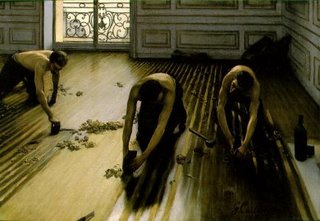Caillebotte

Gustav Caillebotte was born on this day in 1848 in Paris.
In his day, Caillebotte was thought of as an amateur painter and was much better known for organizing and financing some of the great exhibitions of Impressionist painting in Paris, showing side by side the works of such artists as Monet, Manet, Renoir, Pissarro, Degas, Sisley and Cezanne. Younger than the great painters, he was still a law student when Monet and Renoir started discussing the idea of a group exhibition. Caillebotte, who designed brightly sailed racing boats as a sidelight, befriended Monet, his neighbor at Argentueil, created a floating studio for him and infected Monet with his passion for gardening.
Behind the scenes in Paris, Caillebotte did more than almost anyone to further the Impressionist movement, raising funds to keep the artists clothed and sheltered and using his considerable skills at organization, diplomacy and advocacy to carve a niche of respectability for the rogue painters.
His own paintings, beginning in the 1870s, are powerful examples of the movement he helped to foster: in such works as Pont de l'Europe (1876), Paris Street: Rainy Day (1876-77) and The Floor Strippers (1875), Caillebotte shows a preference for viewing urban scenes from unusual viewpoints. Seemingly unstudied compositionally, Caillebotte paintings appear to be snapshots, catching ordinary people in unlikely spots within the frame of view: his figures often enter the foreground abruptly, or walk away with faces momentarily hidden by umbrellas or hats -- caring little for the artist's ordinary sense of order and harmony. Caillebotte combined this pictorial immediacy with a delicate sense of color and lighting effects, certainly less ethereal than his friend Monet, for example, and perhaps closer in spirit to the work of Manet or Degas.
When he died in 1894, Caillebotte bequeathed his personal collection of Impressionist works to the French government, which at the time was unfortunately unprepared to deal with such treasures, keeping them hidden from view for many years. Finally, most of the works in Caillebotte's bequest were permanently displayed at the Musee d'Orsay in Paris.

Labels: Painting and Sculpture, Paris





0 Comments:
Post a Comment
Subscribe to Post Comments [Atom]
<< Home